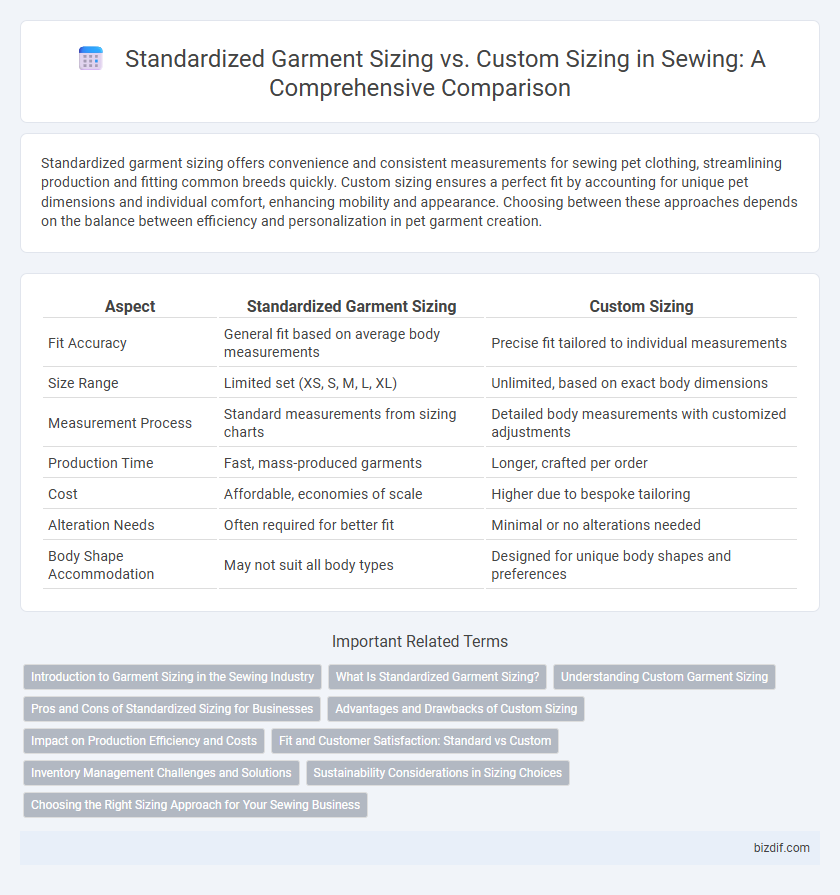Standardized garment sizing offers convenience and consistent measurements for sewing pet clothing, streamlining production and fitting common breeds quickly. Custom sizing ensures a perfect fit by accounting for unique pet dimensions and individual comfort, enhancing mobility and appearance. Choosing between these approaches depends on the balance between efficiency and personalization in pet garment creation.
Table of Comparison
| Aspect | Standardized Garment Sizing | Custom Sizing |
|---|---|---|
| Fit Accuracy | General fit based on average body measurements | Precise fit tailored to individual measurements |
| Size Range | Limited set (XS, S, M, L, XL) | Unlimited, based on exact body dimensions |
| Measurement Process | Standard measurements from sizing charts | Detailed body measurements with customized adjustments |
| Production Time | Fast, mass-produced garments | Longer, crafted per order |
| Cost | Affordable, economies of scale | Higher due to bespoke tailoring |
| Alteration Needs | Often required for better fit | Minimal or no alterations needed |
| Body Shape Accommodation | May not suit all body types | Designed for unique body shapes and preferences |
Introduction to Garment Sizing in the Sewing Industry
Standardized garment sizing provides predefined measurements based on industry-wide size charts to streamline production and ensure consistency across brands. Custom sizing tailors garments to individual body measurements, offering a precise fit that accommodates unique shapes and preferences. Both approaches impact fabric consumption, pattern drafting, and production timelines, influencing the overall efficiency and customer satisfaction in the sewing industry.
What Is Standardized Garment Sizing?
Standardized garment sizing refers to a system of predefined measurements used across the fashion industry to create consistent clothing sizes such as small, medium, and large. These standardized sizes are developed based on population data and anthropometric studies to cater to a broad range of body types. This system simplifies mass production and retail but may lack the precision and fit offered by custom sizing tailored to individual body dimensions.
Understanding Custom Garment Sizing
Custom garment sizing tailors clothing measurements precisely to individual body shapes, enhancing fit and comfort beyond standard sizing charts. By capturing unique dimensions such as shoulder width, waist circumference, and inseam length, custom sizing addresses specific fit challenges common with mass-produced garments. This personalized approach reduces alterations and ensures optimal garment performance, especially important for tailored clothing and specialty wear.
Pros and Cons of Standardized Sizing for Businesses
Standardized garment sizing enables businesses to streamline production processes, reduce manufacturing costs, and simplify inventory management by offering a limited range of sizes. This approach can enhance scalability and quicker turnaround times but often results in fit inconsistencies for diverse body shapes, leading to increased return rates and potential customer dissatisfaction. While standardized sizing supports mass-market appeal and cost efficiency, it may compromise personalized fitting experiences that custom sizing provides.
Advantages and Drawbacks of Custom Sizing
Custom sizing in garment making offers precise fit tailored to an individual's unique body measurements, enhancing comfort and appearance. This method reduces alterations and fabric waste, promoting sustainability compared to standardized sizing. However, custom sizing requires more time, higher costs, and detailed measurements, which can be impractical for mass production or quick purchases.
Impact on Production Efficiency and Costs
Standardized garment sizing streamlines production efficiency by enabling mass manufacturing with consistent patterns, reducing material waste and labor costs. Custom sizing, while improving fit and customer satisfaction, increases production complexity and time, leading to higher expenses due to individualized measurements and adjustments. Balancing standardized sizing with strategic customization can optimize both cost-effectiveness and product quality in garment manufacturing.
Fit and Customer Satisfaction: Standard vs Custom
Standardized garment sizing offers consistency and convenience, but often fails to accommodate individual body variations, leading to fit issues and lower customer satisfaction. Custom sizing ensures garments are tailored precisely to a person's measurements, significantly improving comfort, fit accuracy, and overall satisfaction. Investing in custom sizing enhances customer loyalty by addressing unique body shapes and preferences that standardized sizing cannot match.
Inventory Management Challenges and Solutions
Standardized garment sizing simplifies production but often leads to inventory challenges due to excess stock in unpopular sizes and shortages in high-demand ones. Custom sizing reduces waste by producing garments tailored to individual measurements, minimizing unsold inventory and improving customer satisfaction. Implementing data-driven demand forecasting and flexible manufacturing systems helps balance inventory levels and optimize supply chain efficiency in both sizing approaches.
Sustainability Considerations in Sizing Choices
Standardized garment sizing reduces fabric waste by streamlining production processes and minimizing excess inventory, promoting sustainable manufacturing practices. Custom sizing offers eco-friendly benefits through personalized fits that decrease returns and unsold stock, lowering overall environmental impact. Choosing between these sizing methods requires balancing resource efficiency and consumer demand to optimize sustainability in the fashion industry.
Choosing the Right Sizing Approach for Your Sewing Business
Standardized garment sizing streamlines production and inventory management by using consistent measurements based on industry charts, ideal for mass-market businesses targeting broad demographics. Custom sizing offers precision by tailoring garments to individual measurements, enhancing customer satisfaction and catering to niche markets or luxury segments with unique body shapes. Choosing the right sizing approach depends on your business model's scale, target audience, and desired balance between efficiency and personalization in garment fit.
Standardized Garment Sizing vs Custom Sizing Infographic

 bizdif.com
bizdif.com